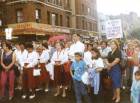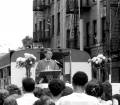






When Bishop-designate John Jenik was ordained by Cardinal Terence Cooke in 1970, he had an idea about the kind of priest he wanted to be. He knew he wanted to work with the burgeoning Hispanic community. He knew he wanted to be an activist priest. He thought he probably would become involved with housing issues.
He did not see some of the other turns his ministry would take. He could not conceive that one day a bullet would pierce the window of his rectory or that he would be shot at from out of the woods while riding his bicycle. Those kinds of things don’t commonly happen to priests.
“It’s taken a lot of turns,” Bishop Jenik said. “I never envisioned anything with the drugs. I never envisioned that. Housing, yes.”
The long-serving pastor of Our Lady of Refuge parish in the Bedford-Fordham section of the Bronx was one of three auxiliary bishops appointed for the archdiocese by Pope Francis June 14. The man the secular media likes to call “the priest in the bulletproof vest” does indeed own one, he acknowledges.
“I gave one away to a fireman. I kept the small one,” he said with a wry smile—and he appears to be exactly the kind of bishop the Holy Father was looking for.
“The Holy Father wants bishops in tune with their people,” Archbishop Carlo Maria Vigano, the apostolic nuncio to the United States, told U.S. Catholic bishops during their annual fall meeting in Baltimore last November. The pontiff, he stressed, “made a special point of saying that he wants ‘pastoral’ bishops, not bishops who profess or follow a particular ideology.”
That would be Father Jenik, who selected “Defend the Poor and Needy” as his bishop’s motto.
The vest stems from Father Jenik’s long fight against the steady encroachment of drugs into his community and even into his own parish where he said he once saw a drug sale going down at the back of the church during Mass.
“It’s insidious,” said the plainspoken priest. “It’s in your face. You go to work in the morning and they’re selling. They’re selling when your kids go to school. They’re selling at night. They were selling drugs in the back of the church. They really don’t care. And the random violence! You never know when it’s going to erupt and who’s going to get shot.”
Drugs were already entrenched in the community when Father Jenik was appointed to Our Lady of Refuge in 1978. It would only get worse as the neighborhood slipped deeper into the control of the drug lords in the 1980s and 1990s. Drugs corrupt everything. Kids would drop out of school because they knew they could make easy money acting as lookouts for the dealers.
Fed up with the drug dealers and with the perceived indifference of the authorities, parishioners at Our Lady of Refuge decided to take action. Father Jenik would lead his congregation into the mean streets on nighttime marches to face down the drug dealers. They offered outdoor Masses at known drug locations, held vigils, boycotted bodegas known to be fronts for drug dealing.
“We just thought in the midst of this somebody has to say it’s wrong and somebody has to call attention to it,” he explained. It was also a way to get more cops on the street. “If you go out like that, the police have to go out to protect you. And people would come out. They’d bring their kids. They saw the value of doing this.”
Parishioners are quick to point out the pastor’s pivotal role.
“He has long been a spearhead in our community efforts against crime and drugs and on immigration issues,” said Zaida Arce, a longtime parishioner. “He’s very level-headed.”
His activism soon earned him the enmity of drug dealers. Shots have been fired through his rectory window. A neighbor once told him he had been asked about the priest’s movements. Shortly after that he heard the unmistakable pop of gunfire as he rode his bicycle through a park by the Botanical Gardens.
“I’m getting near this little bridge over the Bronx River and I hear gun shots,” he recalled. “I thought, ‘Oh my God, who is shooting? It sounds like they’re shooting at me!” He jumped off the bike and called the cops on his cellphone.
“They said, ‘Did you feel the bullets whizzing by?’ I said no, but they were coming right out of the woods that I was going by!” He decided to end the excursion and hightailed it back to the rectory.
Drugs are still a plague on the neighborhood. They don’t appear to be going away anytime soon but at least the area has stabilized.
When Father Jenik first came to Our Lady of Refuge in 1978 the Bronx faced an existential threat. During the 1977 World Series sports broadcaster Howard Cosell famously announced, “There it is, ladies and gentlemen, the Bronx is burning.” Whether the legendary announcer actually said it has been open to debate, but what is irrefutable is that the Bronx was dying when the young priest arrived in the ‘70s.
“People were leaving in droves,” Father Jenik recalled. The South Bronx was pretty much a no-man’s land. But the area around Fordham was still intact, though starting to go. “Fordham Road was the dividing line,” said Father Jenik. “We had to hold the line.”
Working with community activists and organizers Father Jenik established the Bedford Fordham Housing Corporation, a nonprofit organization to help low-income residents find decent, safe and affordable housing and to stave off housing abandonment. The new company would not only provide technical assistance but would take over ownership of properties headed for abandonment. Father Jenik was the president. They acquired their first building on the corner of Briggs Avenue and 194th Street for $100.
“Oh it was awful. It was more than a fixer-upper,” he recalled. “The boiler was falling into an underground stream. So that’s the first one we got that we worked on. Over time the corporation acquired more derelict properties and through volunteer efforts rehabilitated them.
“Now we have 140 buildings and 3,000 apartments,” he said proudly.
Though rents in the neighborhood are still reasonable by New York standards today, there are very few vacancies and rents are slowly but surely on the rise.
In his new capacity, Bishop Jenik will remain at the parish where he has served for 36 years. He is very happy about that, as are his parishioners. He has been in the Bronx 44 years, first at St. Jerome’s, 1970-1974, then at St. Thomas Aquinas, 1974-1978, where he first began his 40-years of dedicated service to provide affordable housing and fight crime, corruption and prostitution. He has also served as regional vicar for the North Bronx since 2006. He said Cardinal Dolan has asked him to be Episcopal Vicar for the Bronx.
Always straightforward, when asked if he would have accepted this position if it meant leaving his beloved Bronx parish, Bishop Jenik responded, “I probably would have said no.”
“It’s an alive parish,” he asserted. “It has great people and they have very great faith. They went on the drug marches, the midnight processions. They supported all that. It wasn’t just me. They have tremendous spirit.”